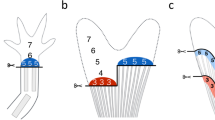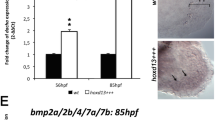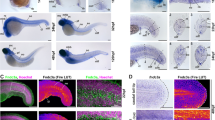Abstract
Regulation of size is one of the fundamental problems in biology. One general strategy has been to identify molecules required for cell growth and cell proliferation within an organ. This has been particularly revealing, identifying cell-autonomous pathways involved in cell growth, survival and proliferation. In order to identify pathways regulating overall limb growth and morphology, experiments have evaluated gene expression, transplanted and removed tissues, and knocked out genes. This work has provided a vast amount of information identifying molecular mechanisms regulating limb axis formation, outgrowth, and pattern formation. Using the zebrafish fin, genetic, cellular and molecular strategies have also been employed to follow both normal patterns of fin growth and growth in fin mutants. This review will focus on cellular and molecular regulation of the outgrowth and patterning of the zebrafish caudal fin during regeneration, and will emphasize similarities to other systems. Future perspectives describe opportunities using the zebrafish fin to reveal mechanisms underlying the regulation of final size.
This is a preview of subscription content, access via your institution
Access options
Subscribe to this journal
Receive 12 print issues and online access
$259.00 per year
only $21.58 per issue
Buy this article
- Purchase on Springer Link
- Instant access to full article PDF
Prices may be subject to local taxes which are calculated during checkout




Similar content being viewed by others
References
Pueyo, J.I. & Couso, J.P. Parallels between the proximal-distal development of vertebrate and arthropod appendages: homology without an ancestor? Curr. Opin. Genet. Dev. 15, 439–446 (2005).
Shubin, N., Tabin, C. & Carroll, S. Fossils, genes and the evolution of animal limbs. Nature 388, 639–648 (1997).
Capdevila, J. & Johnson, R.L. Hedgehog signaling in vertebrate and invertebrate limb patterning. Cell. Mol. Life Sci. 57, 1682–1694 (2000).
Capdevila, J. & Izpisua Belmonte, J.C. Patterning mechanisms controlling vertebrate limb development. Annu. Rev. Cell Dev. Biol. 17, 87–132 (2001).
Amsterdam, A. & Hopkins, N. Mutagenesis strategies in zebrafish for identifying genes involved in development and disease. Trends Genet. 22, 473–478 (2006).
Lieschke, G.J. & Currie, P.D. Animal models of human disease: zebrafish swim into view. Nat. Rev. Genet. 8, 353–367 (2007).
van Eeden, F.J. et al. Genetic analysis of fin formation in the zebrafish, Danio rerio. Development 123, 255–262 (1996).
Amsterdam, A. & Hopkins, N. Retrovirus-mediated insertional mutagenesis in zebrafish. Methods Cell Biol. 60, 87–98 (1999).
Johnson, S.L. & Weston, J.A. Temperature-sensitive mutations that cause stage-specific defects in zebrafish fin regeneration. Genetics 141, 1583–1595 (1995).
Poss, K.D., Nechiporuk, A., Hillam, A.M., Johnson, S.L. & Keating, M.T. Mps1 defines a proximal blastemal proliferative compartment essential for zebrafish fin regeneration. Development 129, 5141–5149 (2002).
Nabrit, S.M. The role of the fin rays in the regeneration in the tail-fins of fishes. Biol. Bull. 56, 235–266 (1929).
Goss, R.J. & Stagg, M.W. The regeneration of fins and fin rays in fundulus heteroclitus. J. Exp. Zool. 137, 487–507 (1957).
Laforest, L. et al. Involvement of the Sonic Hedgehog, patched 1 and bmp2 genes in patterning of the zebrafish dermal fin rays. Development 125, 4175–4184 (1998).
Poss, K.D., Shen, J. & Keating, M.T. Induction of lef1 during zebrafish fin regeneration. Dev. Dyn. 219, 282–286 (2000).
Iovine, M.K., Higgins, E.P., Hindes, A., Coblitz, B. & Johnson, S.L. Mutations in connexin43 (GJA1) perturb bone growth in zebrafish fins. Dev. Biol. 278, 208–219 (2005).
Poss, K.D., Keating, M.T. & Nechiporuk, A. Tales of regeneration in zebrafish. Dev. Dyn. 226, 202–210 (2003).
Poleo, G., Brown, C.W., Laforest, L. & Akimenko, M.A. Cell proliferation and movement during early fin regeneration in zebrafish. Dev. Dyn. 221, 380–390 (2001).
Nechiporuk, A. & Keating, M.T. A proliferation gradient between proximal and msxb-expressing distal blastema directs zebrafish fin regeneration. Development 129, 2607–2617 (2002).
Schebesta, M., Lien, C.L., Engel, F.B. & Keating, M.T. Transcriptional profiling of caudal fin regeneration in zebrafish. ScientificWorldJournal 6, 38–54 (2006).
Poss, K.D. et al. Roles for Fgf signaling during zebrafish fin regeneration. Dev. Biol. 222, 347–358 (2000).
Lee, Y., Grill, S., Sanchez, A., Murphy-Ryan, M. & Poss, K.D. Fgf signaling instructs position-dependent growth rate during zebrafish fin regeneration. Development 132, 5173–5183 (2005).
Thisse, B. & Thisse, C. Functions and regulations of fibroblast growth factor signaling during embryonic development. Dev. Biol. 287, 390–402 (2005).
Stoick-Cooper, C.L. et al. Distinct Wnt signaling pathways have opposing roles in appendage regeneration. Development 134, 479–489 (2007).
Whitehead, G.G., Makino, S., Lien, C.-L. & Keating, M.T. fgf20 is essential for initiating zebrafish fin regeneration. Science 310, 1957–1960 (2005).
Thummel, R. et al. Inhibition of zebrafish fin regeneration using in vivo electroporation of morpholinos against fgfr1 and msxb. Dev. Dyn. 235, 336–346 (2006).
Makino, S. et al. Heat-shock protein 60 is required for blastema formation and maintenance during regeneration. Proc. Natl. Acad. Sci. USA 102, 14599–14604 (2005).
Smith, A., Avaron, F., Guay, D., Padhi, B.K. & Akimenko, M.A. Inhibition of BMP signaling during zebrafish fin regeneration disrupts fin growth and scleroblast differentiation and function. Dev. Biol. 299, 438–454 (2006).
Quint, E. et al. Bone patterning is altered in the regenerating zebrafish caudal fin after ectopic expression of sonic hedgehog and bmp2b or exposure to cyclopamine. Proc. Natl. Acad. Sci. USA 99, 8713–8718 (2002).
Martin, G. Making a vertebrate limb: new players enter from the wings. Bioessays 23, 865–868 (2001).
Martin, G.R. The roles of FGFs in the early development of vertebrate limbs. Genes Dev. 12, 1571–1586 (1998).
Dahn, R.D. & Fallon, J.F. Limbiting outgrowth: BMPs as negative regulators in limb development. Bioessays 21, 721–725 (1999).
Lepilina, A. et al. A dynamic epicardial injury response supports progenitor cell activity during zebrafish heart regeneration. Cell 127, 607–619 (2006).
Iovine, M.K. & Johnson, S.L. Genetic analysis of isometric growth control mechanisms in the zebrafish caudal fin. Genetics 155, 1321–1329 (2000).
Paznekas, W.A. et al. Connexin 43 (GJA1) mutations cause the pleiotropic phenotype of oculodentodigital dysplasia. Am. J. Hum. Genet. 72, 408–418 (2003).
Hoptak-Solga, A.D., Klein, K.A., Derosa, A.M., White, T.W. & Iovine, M.K. Zebrafish short fin mutations in connexin43 lead to aberrant gap junctional intercellular communication. FEBS Lett. 581, 3297–3302 (2007).
Acknowledgements
The author would like to thank A. Brands and K. Poss for comments and critiques of the manuscript.
Author information
Authors and Affiliations
Ethics declarations
Competing interests
The author declares no competing financial interests.
Rights and permissions
About this article
Cite this article
Iovine, M. Conserved mechanisms regulate outgrowth in zebrafish fins. Nat Chem Biol 3, 613–618 (2007). https://doi.org/10.1038/nchembio.2007.36
Published:
Issue Date:
DOI: https://doi.org/10.1038/nchembio.2007.36
This article is cited by
-
Gene expression patterns associated with caudal fin shape in the cichlid Lamprologus tigripictilis
Hydrobiologia (2023)
-
Differential cellular proliferation underlies heterochronic generation of cranial diversity in phyllostomid bats
EvoDevo (2020)
-
Modeling Stripe Formation on Growing Zebrafish Tailfins
Bulletin of Mathematical Biology (2020)
-
ECM alterations in Fndc3a (Fibronectin Domain Containing Protein 3A) deficient zebrafish cause temporal fin development and regeneration defects
Scientific Reports (2019)
-
Towards a gene regulatory network shaping the fins of the Princess cichlid
Scientific Reports (2018)



